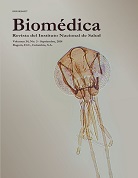Physical activity levels among Colombian adults: Inequalities by gender and socioeconomic status
Abstract
Introduction: Worldwide studies show inequalities in physical activity levels related to socio-demographic characteristics. In Colombia, among the countries in Latin America with the highest inequality, the evidence related to inequalities in physical activity is limited. It is imperative to identify disparities in physical activity in the country, to guide the design of public policies aimed at promoting physical activity.
Objectives: 1) To estimate the prevalence and associated factors of meeting physical activity recommendations; 2) to assess inequalities by gender and socioeconomic status in meeting physical activity recommendations, and 3) to assess the trends in physical activity prevalence within a five-year period.
Materials and methods: A secondary analysis of data from the 2010 National Nutrition Survey was conducted. The sample included 27,243 adults. The International Physical Activity Questionnaire was used to measure leisure time and transport domains. Socioeconomic status was measured by the Sisben level.
Results: Compared to men, women were less likely to meet physical activity recommendations in all domains. Compared to adults from high socioeconomic-status households, low socioeconomic-status adults had a lower prevalence of meeting physical activity recommendations during leisure time and the highest prevalence of using a bicycle for transport. The factors associated with meeting physical activity recommendations differed by gender and physical activity domain. Household and individual variables explained 13.6% of the inequalities observed by gender, and 23.2% of the inequalities by socioeconomic status. In a five-year period, the prevalence of physical activity in leisure time decreased, while the physical activity of walking for transport increased and biking for transport did not change.
Conclusions: Future interventions to increase physical activity levels in Colombia must consider inequalities by gender and socioeconomic status. Of special concern is the low prevalence of meeting physical activity recommendations during leisure time in both women and in the low socioeconomic status population.
Downloads
| Article metrics | |
|---|---|
| Abstract views | |
| Galley vies | |
| PDF Views | |
| HTML views | |
| Other views | |


























